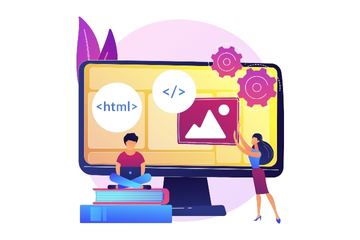
Welcome to V1 Academy, your gateway to mastering web development techniques with our comprehensive courses. In this article, we dive deep into CSS Grid Layouts, a powerful tool for creating responsive and flexible web designs. Our goal is to equip you with the knowledge to build modern web layouts that are both aesthetically pleasing and functionally robust.
Understanding CSS Grid: The Foundation of Modern Layouts
What is CSS Grid?
CSS Grid Layout, often referred to simply as Grid, is a CSS module that enables designers to create complex, responsive web layouts with ease. Unlike traditional layout methods, Grid provides a two-dimensional system, allowing for the design of both rows and columns simultaneously. This makes it an indispensable tool for web developers aiming to build adaptable and user-friendly designs.
Why Learn CSS Grid?
For anyone pursuing a web development course in Kolkata, mastering CSS Grid is crucial. It simplifies the process of creating intricate layouts, reduces the reliance on external frameworks, and offers a more intuitive approach to design. Our courses at V1 Academy ensure that you gain hands-on experience with Grid, preparing you for real-world applications.
Setting Up Your First Grid Container
Creating a Grid Container
To start using CSS Grid, you need to define a grid container. This is the parent element where the grid properties are applied. For instance:
In this example, .container is the grid container, and it is divided into three equal columns with a 10px gap between them.
Defining Grid Tracks
Grid tracks are the rows and columns that form the structure of the grid. The grid-template-columns and grid-template-rows properties are used to define these tracks. Here's a basic setup:
This code creates a grid with three columns, each taking up an equal fraction of the available space, and rows that size automatically based on their content.
Advanced Grid Properties
Fractional Units (fr)
The fr unit represents a fraction of the available space, making it ideal for creating flexible layouts. For example:
In this setup, the first column takes up twice as much space as the second column.
The repeat() Function
The repeat() function allows for a more concise way to define repetitive columns or rows. For example:
This creates a grid with four equal columns.
Auto-Fit and Auto-Fill
These functions dynamically adjust the number of columns or rows to fit the available space:
Here, columns will automatically resize to fit the container, maintaining a minimum width of 150px.
Building Responsive Designs with CSS Grid
Using Media Queries
Combining CSS Grid with media queries allows for adaptive layouts that respond to different screen sizes. For instance:
This layout changes from a single column to two columns when the viewport is 768px or wider.
Grid Template Areas
The grid-template-areas property provides a visual way to define the layout of a grid, making your CSS more readable and easier to manage:
This code creates a layout with designated areas for the header, sidebar, main content, and footer.
Practical Applications of CSS Grid in Modern Web Design
Creating Dynamic Landing Pages
CSS Grid is perfect for designing dynamic landing pages. For example:
This structure provides a clean and organized layout, ensuring each section of the landing page is well-defined.
Designing Product Galleries
For e-commerce websites, CSS Grid simplifies the creation of product galleries:
This setup ensures that product items adapt to the available space, providing a consistent and visually appealing gallery.
Implementing Grids in Web Development Courses in Kolkata
At V1 Academy, we emphasize the practical applications of CSS Grid in our web development course in Kolkata. Students learn to apply Grid techniques to create responsive and visually appealing web layouts, preparing them for industry demands. By mastering CSS Grid, our students are equipped to handle modern web design challenges, making them valuable assets in the field of web development.
Best Practices for Using CSS Grid
Combining Grid and Flexbox
While CSS Grid excels at creating overall layouts, Flexbox is ideal for aligning elements within grid items. Using both can provide a more flexible and robust design approach:
Here, the grid defines the layout, and Flexbox handles the alignment within each grid item.
Ensuring Accessibility
When using CSS Grid, it's important to maintain accessibility. This includes keeping a logical reading order and ensuring that your grid layout does not confuse screen readers. Using semantic HTML elements and ARIA roles can help achieve this.
Optimizing Performance
Efficient use of CSS Grid can enhance website performance. Avoid overly complex grids and ensure that your grid calculations do not significantly impact rendering performance. Keep your CSS concise and well-organized to maintain fast load times and responsive design.
Cross-Browser Compatibility
Although CSS Grid is widely supported across modern browsers, it's essential to ensure compatibility with older versions. Implementing fallbacks or using tools like Autoprefixer can help maintain a consistent experience across different browsers.
Conclusion
Mastering CSS Grid Layouts is essential for creating responsive and flexible web designs. At V1 Academy, we integrate CSS Grid into our web development course in Kolkata, providing students with the skills needed to build modern and adaptable web layouts. By understanding and applying the advanced features of CSS Grid, you can create designs that stand out in the competitive digital landscape, offering users an optimal experience across devices.
Embrace the power of CSS Grid with V1 Academy and elevate your web development skills to new heights. Whether you are designing dynamic landing pages or complex product galleries, CSS Grid offers the tools needed to build responsive, flexible, and visually stunning web layouts.
For more details on web development course in Kolkata, connect with the team!

No Experience? No Problem. Here's Why a Basic Computer Course Could Be Your Best First Step

Design Your Future: Why a Graphic Design Course Is More Than Just Art

Why Every Student - No Matter the Degree - Should Learn to Code

From Learner to Innovator: How a Mobile App Development Course Can Accelerate Your Career

Your Passion, Your Code, Your Triumph: Learn Programming to Conquer Your Fears

Turn Your Imagination into Income: Why Graphic Design Is the Skill You Need Now

Own Your Destiny: Why Every Student Must Learn SEO & Digital Marketing Now

Feeling Lost After 12th? Discover How Mobile App Development Can Shape Your Bright Future

What They Don’t Teach in YouTube Tutorials: 5 Web Development Secrets Only Real Courses Offer

Dreaming of a Career in Tech? Start Here with Our Programming & Development Course

Can You Learn Computers Without Any Experience? YES, and Here’s How

Tired of Feeling Left Behind? Learn Digital Marketing and Take Control of Your Future